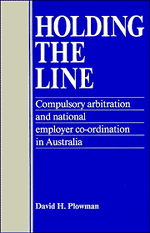Book contents
- Frontmatter
- Contents
- List of tables and figures
- List of abbreviations
- Acknowledgements
- Introduction
- Dedication
- 1 Industrial legislation and the rise of permanent employer associations 1890–1906
- 2 The Higgins era 1907–1920
- 3 Rival shops 1921–1929
- 4 Depression and recovery 1930–1939
- 5 War and government executive action 1940–1949
- 6 Consolidation 1950–1959
- 7 The National Employers' Associations 1960–1972
- 8 Confederation 1973–1988
- 9 Models of national employer co-ordination
- Appendices
- Bibliography
- Records of organisations
- Index
3 - Rival shops 1921–1929
Published online by Cambridge University Press: 05 November 2011
- Frontmatter
- Contents
- List of tables and figures
- List of abbreviations
- Acknowledgements
- Introduction
- Dedication
- 1 Industrial legislation and the rise of permanent employer associations 1890–1906
- 2 The Higgins era 1907–1920
- 3 Rival shops 1921–1929
- 4 Depression and recovery 1930–1939
- 5 War and government executive action 1940–1949
- 6 Consolidation 1950–1959
- 7 The National Employers' Associations 1960–1972
- 8 Confederation 1973–1988
- 9 Models of national employer co-ordination
- Appendices
- Bibliography
- Records of organisations
- Index
Summary
The previous chapter outlined developments from 1907 to 1920. During this period the major activity of the Central Council of Employers of Australia was to restrict the federal arbitration system. Until 1913 the CCEA was successful on this front. Thereafter its High Court challenges merely opened the way for an expanded federal jurisdiction. The High Court's test of legal inconsistency adopted in 1910 allowed for a situation of overlapping federal and state awards. This enabled unions to treat tribunals as ‘rival shops’, to seek award variations from one tribunal in the knowledge that it could not reduce standards already determined by the other tribunal; to pick the most favourable combination of employment standards from their federal and state awards; and to jettison federal awards when it suited. The rationalisation of dual regulation became a major preoccupation of both employers and legislatures during the 1920s. Attempts to rationalise dual regulation included increasing the Commonwealth's industrial powers by the conferring of such powers by the states or by referendum, and, conversely, the Commonwealth vacating the industrial field in favour of the states. These developments are reviewed in the first part of this chapter. It also examines the emergence of basic wage and standard hours test cases during the period. Such test cases necessitated union and employer coordination. The organisational developments of the Central Council and its activities to bring about a ‘closer organisation of employers’ are reviewed in the second part of the chapter.
- Type
- Chapter
- Information
- Holding the LineCompulsory Arbitration and National Employer Co-ordination in Australia, pp. 48 - 74Publisher: Cambridge University PressPrint publication year: 1989



